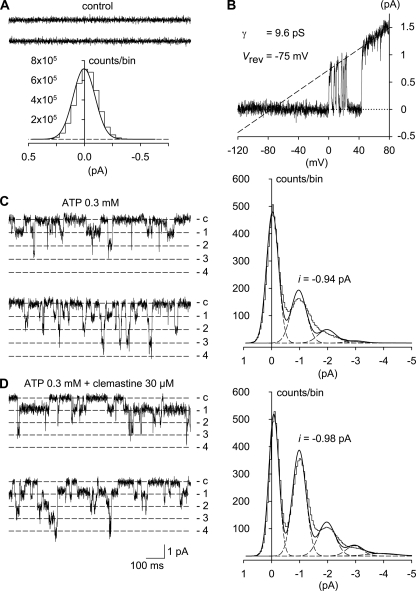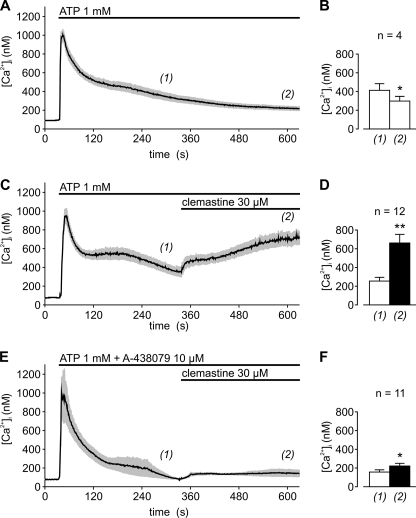
| Size | Price | Stock | Qty |
|---|---|---|---|
| 100mg |
|
||
| 250mg |
|
||
| 500mg |
|
||
| 1g |
|
||
| 2g |
|
||
| 5g |
|
||
| Other Sizes |
|
Purity: ≥98%
Clemastine Fumarate (HS-592; HS 592 fumarate; Meclastine), the fumarate salt of clemastine, is a first-generation H1 histamine antagonist with anticholinergic and sedative adverse effects. It has an IC50 of 3 nM for H1 histamine receptor inhibition. Clemastine is used as the hydrogen fumarate in hay fever, rhinitis, allergic skin conditions, and pruritus. It also relieves sneezing, runny nose, and red, itchy, and tearing eyes.
| Targets |
mTOR; Histamine H1 receptor ( IC50 = 3 nM )
|
|
|---|---|---|
| ln Vitro |
|
|
| ln Vivo |
|
|
| Enzyme Assay |
In a buffer containing 138 mM NaCl, 6 mM KC1, 1 mM MgSO4, 1 mM Na2HPO4, 5 mM NaHCO33, 5.5 mM glucose, and 20 mM HEPES-NaOH, pH 7.4, HL-60 cells are suspended at a density of 1×107 cells/mL. The buffer is further enhanced with 0.1% (w/v) bovine serum albumin. Following a 10-minute incubation period at 37 °C, 4 μM of the dye fura-2/AM is added to the cells. After being diluted with the previously mentioned buffer to a concentration of 5×106 cells/mL, the cells are incubated at 37 °C for 45 minutes. Following this, cells are diluted using the previously mentioned buffer until they reach a final concentration of 0.5 × 106 cells/mL, and they are centrifuged at 250 g for 10 minutes at ambient temperature. In the previously mentioned buffer, cells are suspended at 1.0 × 106 cells/mL and stored at 20 °C until measurement. After loading with fura-2/AM, HL-60 cells are suspended in 2 mL of the previously mentioned buffer for a maximum of 4 hours using acryl fluorescence cuvettes. Prior to the addition of histamine (100 μM), HL-60 cells are incubated for 3 minutes at 37 °C with 1 mM Ca2+ and different concentrations of clemastine fumarate. With the cells constantly stirred at 1×103 rpm and at 37 °C, fluorescence is measured with a Ratio II spectrofluorometer. For one minute, the basal fluorescence, or basal [Ca2+]i, is measured. To find the increase in [Ca2+]i, the corresponding peak [Ca2+]i values are subtracted from the basal [Ca2+]i values. The wavelengths of excitation and emission are 500 nm and 340 nm, respectively. The competitive curve is used to calculate the IC50 value.
|
|
| Animal Protocol |
Male Wistar rats with paw oedema induced by subplantar injection of zymosan and ear oedema induced by croton oil
5-20 mg/kg Intraperitoneally |
|
| References |
[1]. Mol Pharmacol . 1992 Aug;42(2):227-34. [2]. Cell Immunol . 1983 Oct 1;81(1):45-60. [3]. J Pharmacol Exp Ther . 1997 Jan;280(1):114-21. [4].J Mol Cell Cardiol . 2006 Jan;40(1):107-18. [5]. J Biol Chem . 2011 Apr 1;286(13):11067-81. [6]. J Pharmacol Exp Ther . 1997 Jan;280(1):114-21. |
| Molecular Formula |
C25H30CLNO5
|
|
|---|---|---|
| Molecular Weight |
459.96
|
|
| Exact Mass |
459.18
|
|
| Elemental Analysis |
C, 65.28; H, 6.57; Cl, 7.71; N, 3.05; O, 17.39
|
|
| CAS # |
14976-57-9
|
|
| Related CAS # |
Clemastine; 15686-51-8; Clemastine-d5 fumarate
|
|
| Appearance |
White to light yellow crystalline powder
|
|
| SMILES |
C[C@@](C1=CC=CC=C1)(C2=CC=C(C=C2)Cl)OCC[C@H]3CCCN3C.C(=C/C(=O)O)\C(=O)O
|
|
| InChi Key |
PMGQWSIVQFOFOQ-YKVZVUFRSA-N
|
|
| InChi Code |
InChI=1S/C21H26ClNO.C4H4O4/c1-21(17-7-4-3-5-8-17,18-10-12-19(22)13-11-18)24-16-14-20-9-6-15-23(20)2;5-3(6)1-2-4(7)8/h3-5,7-8,10-13,20H,6,9,14-16H2,1-2H3;1-2H,(H,5,6)(H,7,8)/b;2-1+/t20-,21-;/m1./s1
|
|
| Chemical Name |
(E)-but-2-enedioic acid;(2R)-2-[2-[(1R)-1-(4-chlorophenyl)-1-phenylethoxy]ethyl]-1-methylpyrrolidine
|
|
| Synonyms |
|
|
| HS Tariff Code |
2934.99.9001
|
|
| Storage |
Powder -20°C 3 years 4°C 2 years In solvent -80°C 6 months -20°C 1 month Note: Please store this product in a sealed and protected environment, avoid exposure to moisture. |
|
| Shipping Condition |
Room temperature (This product is stable at ambient temperature for a few days during ordinary shipping and time spent in Customs)
|
| Solubility (In Vitro) |
|
|||
|---|---|---|---|---|
| Solubility (In Vivo) |
Solubility in Formulation 1: ≥ 1.43 mg/mL (3.11 mM) (saturation unknown) in 10% DMSO + 40% PEG300 + 5% Tween80 + 45% Saline (add these co-solvents sequentially from left to right, and one by one), clear solution.
For example, if 1 mL of working solution is to be prepared, you can add 100 μL of 14.3 mg/mL clear DMSO stock solution to 400 μL PEG300 and mix evenly; then add 50 μL Tween-80 to the above solution and mix evenly; then add 450 μL normal saline to adjust the volume to 1 mL. Preparation of saline: Dissolve 0.9 g of sodium chloride in 100 mL ddH₂ O to obtain a clear solution. Solubility in Formulation 2: ≥ 1.43 mg/mL (3.11 mM) (saturation unknown) in 10% DMSO + 90% (20% SBE-β-CD in Saline) (add these co-solvents sequentially from left to right, and one by one), clear solution. For example, if 1 mL of working solution is to be prepared, you can add 100 μL of 14.3 mg/mL clear DMSO stock solution to 900 μL of 20% SBE-β-CD physiological saline solution and mix evenly. Preparation of 20% SBE-β-CD in Saline (4°C,1 week): Dissolve 2 g SBE-β-CD in 10 mL saline to obtain a clear solution. View More
Solubility in Formulation 3: ≥ 1.43 mg/mL (3.11 mM) (saturation unknown) in 10% DMSO + 90% Corn Oil (add these co-solvents sequentially from left to right, and one by one), clear solution. Solubility in Formulation 4: 30% propylene glycol, 5% Tween 80, 65% D5W: 5mg/mL Solubility in Formulation 5: 1.43 mg/mL (3.11 mM) in PBS (add these co-solvents sequentially from left to right, and one by one), clear solution; with ultrasonication (<60°C). |
| Preparing Stock Solutions | 1 mg | 5 mg | 10 mg | |
| 1 mM | 2.1741 mL | 10.8705 mL | 21.7410 mL | |
| 5 mM | 0.4348 mL | 2.1741 mL | 4.3482 mL | |
| 10 mM | 0.2174 mL | 1.0871 mL | 2.1741 mL |
*Note: Please select an appropriate solvent for the preparation of stock solution based on your experiment needs. For most products, DMSO can be used for preparing stock solutions (e.g. 5 mM, 10 mM, or 20 mM concentration); some products with high aqueous solubility may be dissolved in water directly. Solubility information is available at the above Solubility Data section. Once the stock solution is prepared, aliquot it to routine usage volumes and store at -20°C or -80°C. Avoid repeated freeze and thaw cycles.
Calculation results
Working concentration: mg/mL;
Method for preparing DMSO stock solution: mg drug pre-dissolved in μL DMSO (stock solution concentration mg/mL). Please contact us first if the concentration exceeds the DMSO solubility of the batch of drug.
Method for preparing in vivo formulation::Take μL DMSO stock solution, next add μL PEG300, mix and clarify, next addμL Tween 80, mix and clarify, next add μL ddH2O,mix and clarify.
(1) Please be sure that the solution is clear before the addition of next solvent. Dissolution methods like vortex, ultrasound or warming and heat may be used to aid dissolving.
(2) Be sure to add the solvent(s) in order.
| NCT Number | Recruitment | interventions | Conditions | Sponsor/Collaborators | Start Date | Phases |
| NCT06039137 | Active Recruiting |
Drug: Cetirizine | Solid Tumor | Erasmus Medical Center | June 1, 2022 | N/A |
| NCT03109288 | Recruiting | Drug: Pioglitazone Drug: clemastine fumarate Drug: Dantrolene Drug: Pirfenidone |
Multiple Sclerosis | National Institute of Allergy and Infectious Diseases (NIAID) |
August 11, 2017 | Phase 1 Phase 2 |
| NCT02521311 | Recruiting | Drug: Clemastine Drug: Placebo |
Optic Neuritis | University of California, San Francisco |
February 28, 2017 | Phase 2 |
| NCT05359653 | Recruiting | Drug: Clemastine Fumarate Drug: Placebo |
Multiple Sclerosis (MS) Multiple Sclerosis Relapse Multiple Sclerosis Benign |
University of California, San Francisco |
August 1, 2023 | Phase 1 Phase 2 |
| NCT06065670 | Not yet recruiting | Drug: Clemastine Fumarate Drug: Placebo |
Demyelinating Diseases Multiple Sclerosis Brain Lesion |
University of California, San Francisco |
November 1, 2023 | Phase 1 Phase 2 |
 |
|---|
 |
 |